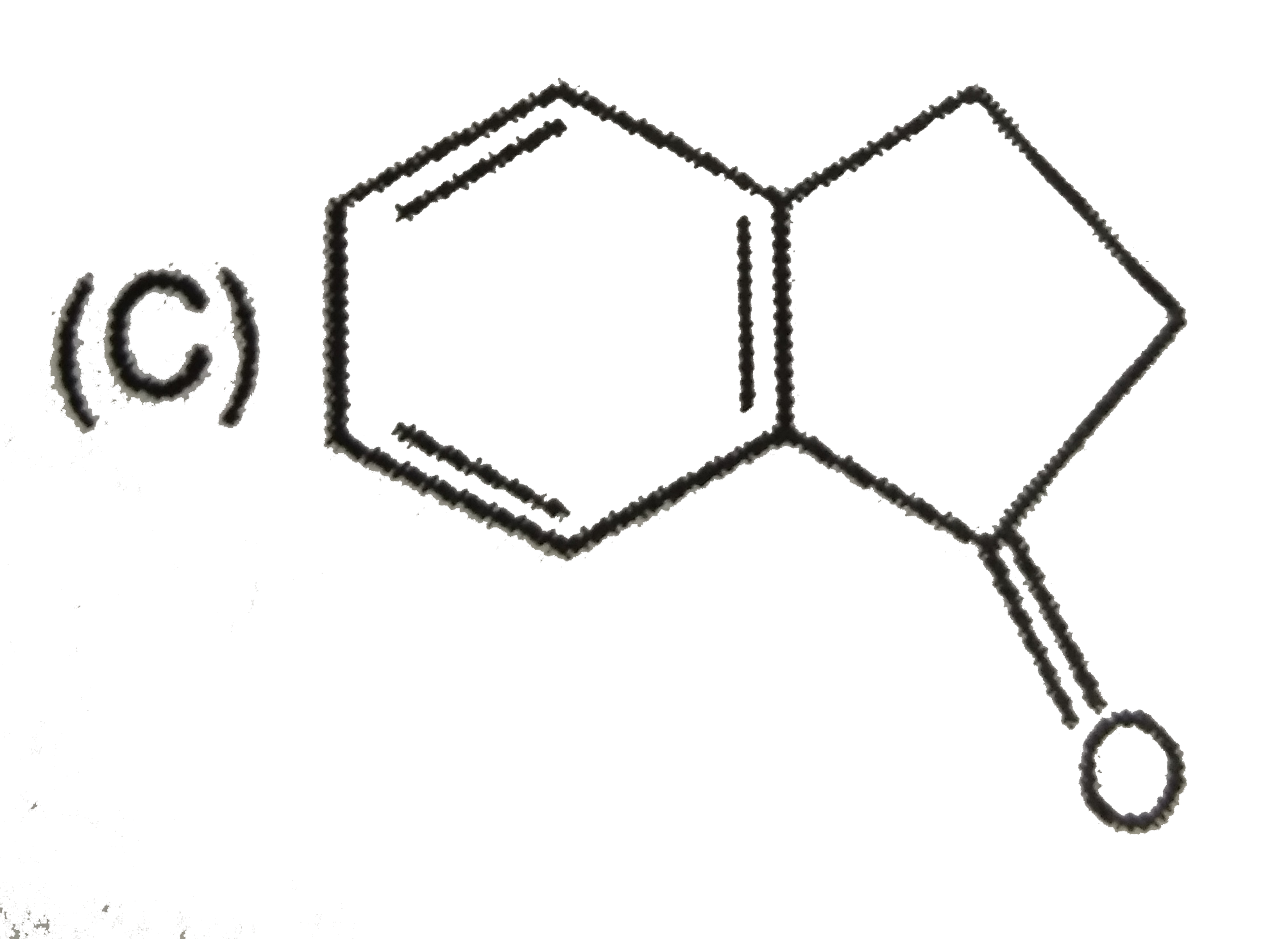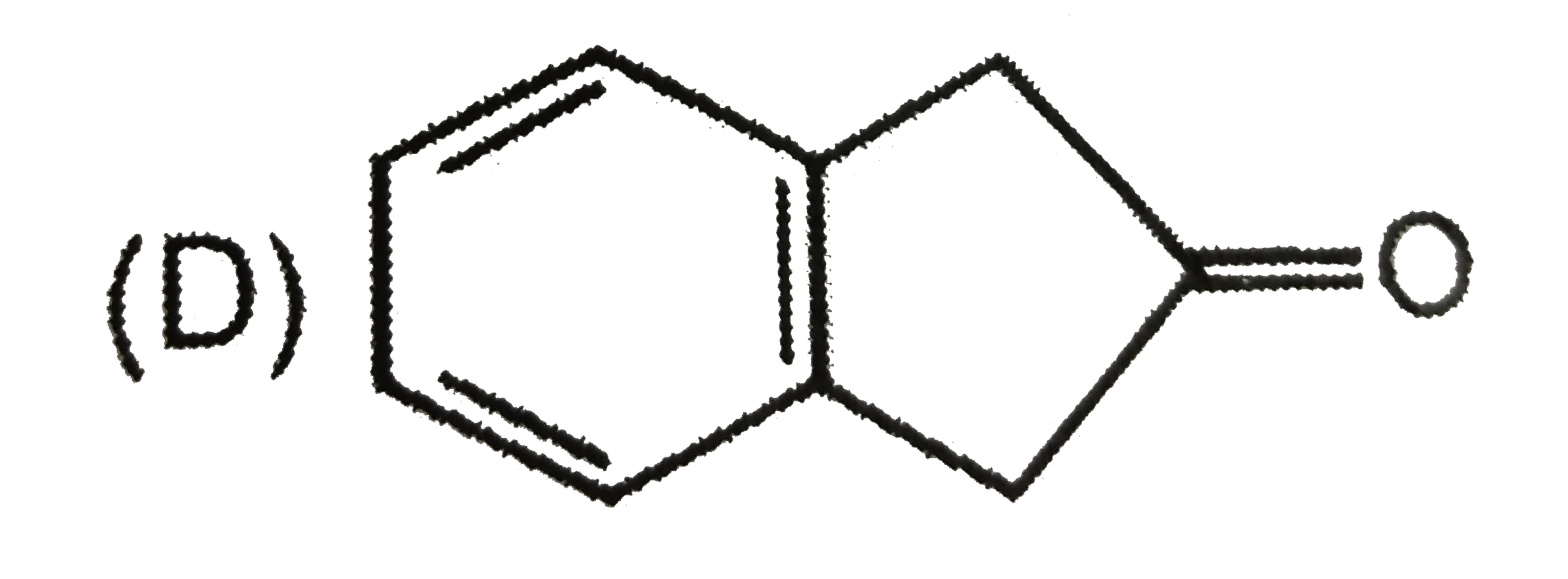In the following reaction sequence, the compound J is an
interemediate
I(CH3CO)2O−−−−−−−−−−→CH3COONaJ(i)H2,Pd/C−−−−−−−−−−−−→(ii)SOCl2(iii)anhyd.AlCl3K
J(C9H8O2) gives effervsecence on the treament withNaHCHO3
and positive Baeyr's test.
The compound K, is




The correct Answer is:C
To solve the problem step by step, let's break down the reaction sequence and identify the compounds involved.
Step 1: Identify Compound I
The question states that compound I is a benzene ring attached to an aldehyde group. This can be represented as:
- Compound I: C₆H₅CHO (Benzaldehyde)
Step 2: Reaction of Compound I to Form Compound J
Compound I reacts with sodium acetate (CH₃COONa) in the presence of acetic anhydride ((CH₃CO)₂O). This reaction is known as the Perkin reaction, which leads to the formation of a cinnamic acid derivative. The product J can be represented as:
- Compound J: C₉H₈O₂ (Cinnamic Acid: C₆H₅-CH=CH-COOH)
Step 3: Properties of Compound J
The problem states that compound J gives effervescence upon treatment with sodium bicarbonate (NaHCO₃) and gives a positive Baeyer's test.
- The effervescence indicates the presence of a carboxylic acid group, which is consistent with the structure of cinnamic acid.
- A positive Baeyer's test indicates the presence of an alkene (C=C bond), which is also present in cinnamic acid.
Step 4: Reaction of Compound J to Form Compound K
Next, compound J (Cinnamic Acid) undergoes hydrogenation in the presence of Pd/C (palladium on carbon) to reduce the double bond (C=C) to a single bond (C-C), resulting in:
- Intermediate after hydrogenation: C₆H₅-CH₂-COOH (Phenylpropanoic acid)
Step 5: Reaction of Intermediate with SOCl₂
The intermediate then reacts with thionyl chloride (SOCl₂), which converts the carboxylic acid group (-COOH) into an acyl chloride (-COCl):
- Intermediate after reaction with SOCl₂: C₆H₅-CH₂-COCl
Step 6: Friedel-Crafts Acylation
Finally, the acyl chloride undergoes Friedel-Crafts acylation in the presence of anhydrous AlCl₃, which introduces an acyl group onto the benzene ring:
- Final Compound K: C₉H₉Cl (Benzoyl chloride derivative)
Conclusion
The final compound K is a product of Friedel-Crafts acylation, which is a benzene ring with an acyl group.
Final Answer
- Compound K: C₉H₉Cl (Benzoyl chloride derivative)
---
The question states that compound I is a benzene ring attached to an aldehyde group. This can be represented as:
- Compound I: C₆H₅CHO (Benzaldehyde)
Compound I reacts with sodium acetate (CH₃COONa) in the presence of acetic anhydride ((CH₃CO)₂O). This reaction is known as the Perkin reaction, which leads to the formation of a cinnamic acid derivative. The product J can be represented as:
- Compound J: C₉H₈O₂ (Cinnamic Acid: C₆H₅-CH=CH-COOH)
The problem states that compound J gives effervescence upon treatment with sodium bicarbonate (NaHCO₃) and gives a positive Baeyer's test.
- The effervescence indicates the presence of a carboxylic acid group, which is consistent with the structure of cinnamic acid.
- A positive Baeyer's test indicates the presence of an alkene (C=C bond), which is also present in cinnamic acid.
Next, compound J (Cinnamic Acid) undergoes hydrogenation in the presence of Pd/C (palladium on carbon) to reduce the double bond (C=C) to a single bond (C-C), resulting in:
- Intermediate after hydrogenation: C₆H₅-CH₂-COOH (Phenylpropanoic acid)
The intermediate then reacts with thionyl chloride (SOCl₂), which converts the carboxylic acid group (-COOH) into an acyl chloride (-COCl):
- Intermediate after reaction with SOCl₂: C₆H₅-CH₂-COCl
Finally, the acyl chloride undergoes Friedel-Crafts acylation in the presence of anhydrous AlCl₃, which introduces an acyl group onto the benzene ring:
- Final Compound K: C₉H₉Cl (Benzoyl chloride derivative)
The final compound K is a product of Friedel-Crafts acylation, which is a benzene ring with an acyl group.
- Compound K: C₉H₉Cl (Benzoyl chloride derivative)
Topper's Solved these Questions
- CARBONYL COMPOUNDS (ALDEHYDES & KETONES ) & CARBOXYLIC ACID BOOK - RESONANCE ENGLISHCHAPTER - CARBONYL COMPOUNDS (ALDEHYDES & KETONES ) & CARBOXYLIC ACID EXERCISE - PART- IV
13 Videos
- CARBONYL COMPOUNDS (ALDEHYDES & KETONES ) & CARBOXYLIC ACID BOOK - RESONANCE ENGLISHCHAPTER - CARBONYL COMPOUNDS (ALDEHYDES & KETONES ) & CARBOXYLIC ACID EXERCISE - Exercise-3
1 Videos
- CARBONYL COMPOUNDS (ALDEHYDES & KETONES ) & CARBOXYLIC ACID BOOK - RESONANCE ENGLISHCHAPTER - CARBONYL COMPOUNDS (ALDEHYDES & KETONES ) & CARBOXYLIC ACID EXERCISE - Exercise-2 Part-I
1 Videos
- BIOMOLECULES & POLYMERBOOK - RESONANCE ENGLISHCHAPTER - BIOMOLECULES & POLYMEREXERCISE - ORGANIC CHEMISTRY(Biomolecules & Polymer)
34 Videos
- CHEMICAL KINETICSBOOK - RESONANCE ENGLISHCHAPTER - CHEMICAL KINETICSEXERCISE - PHYSICAL CHEMITRY (CHEMICAL KNIETICS & RADIOACTIVITY)
49 Videos
Similar Questions
Knowledge Check
In the following reaction sequence,
CH3−C∣OH(X)H−CH3[O]−−→YCH3MgBr−−−−−−−−→H+/H2OZ
Z isAbutan-1-olBbutan-2-olC2-methylpropan-2-olD1,1 - dimethylethanol.Compounds A and C in the following reaction are
CH3CHO(i)CH3MgBr−−−−−−−−→(ii)H2OAH2SO4.Δ−−−−−−→(B)Hydroboration oxidation−−−−−−−−−−−−−−→(C)AidenticalBpositional isomersCfunctional isomersDoptical isomers.Compounds A and C in the following reaction are
CH3CHO(i)CH3MgBr−−−−−−−−→(ii)H2OAH2SO4.Δ−−−−−−→(B)Hydroboration oxidation−−−−−−−−−−−−−−→(C)AidenticalBpositional isomersCfunctional isomersDoptical isomers.
Complete the following reaction sequence :
CH3−O∣∣C−CH3(i)CH3MgBr−−−−−−−−→(ii)H2O(A)Na metal−−−−→ether(B)CH3−Br−−−−−→(C)
View SolutionIn the given reaction sequences the final product 'C' is
CH3−CH2−OH(i)KMnO4/−OH/Δ−−−−−−−−−−−−−−−→(ii)H2O+(A)(i)SOCl2−−−−−−−−→(ii)NH3(B)Br2/KOH−−−−−−→(C)
View SolutionIn the following reaction, trace the position of isotopic O18
CH3−O∣∣C−O−H+CH3CH2−18O−H⇔CH3−O∣∣C−O−CH2CH3
+H2O
View SolutionIdentify Z in the following reaction sequence.
CH3IMg−−→EtherXDry ice−−−→H3O+YCl2−−→Red PZ
View SolutionIn the following sequence of reactions, the alkene formed the compound ‘B’
CH3CH2CH=CHCH2CH3O3−−→AH2O−−→ZnB
The compound B is :
View Solution
